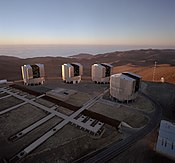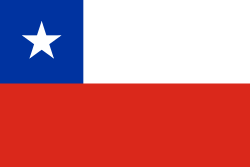Paranalobservatoriet
| Paranalobservatoriet | ||||||
(c) ESO, CC BY 4.0 Flygbild över observatoriet. | ||||||
| Organisation | European Southern Observatory (ESO) | |||||
|---|---|---|---|---|---|---|
| Kod | 309 | |||||
| Plats | Cerro Paranal, Taltal, | |||||
| Koordinater | 24°37′38″S 70°24′15″V / 24.62722°S 70.40417°V | |||||
| Altitud | 2 635 meter över havet. | |||||
| Webbplats | Paranalobservatoriets hemsida | |||||
| ||||||

Paranalobservatoriet är ett observatorium som ligger på berget Cerro Paranal i Taltal, Chile.[1]. Observatoriet invigdes 1996 av Chiles president Eduardo Frei Ruiz-Tagle och Sveriges kung Carl XVI Gustaf.[1] Sverige är ett av de länder som varit med och bekostat observatoriet.[2]. Första bilden från observatoriet kom 1998[1]
På observatoriet finns bland annat det just nu mest avancerade markbaserade teleskopet för att mäta synligt ljus.[3] Det heter VLT (Very Large Telescope) och är uppbyggt av fyra teleskop som kan samverka för att fungera som ett femte instrument.[1]. Driften av observatoriet sköts av European Southern Observatory (ESO).[4]
På området kring Paranalobservatoriet finns hotellet Residencia som förekommer i James Bond-filmen Quantum of Solace.[5]
Instrument på Paranalobservatoriet
- VLT (Very Large Telescope)
- VLTi (Very Large Telescope Interferometer)
- 4 AT (Auxiliary Telescopes)
- VLT Survey Telescope
- VISTA Telescope Survey
Referenser
- ^ [a b c d] ”Paranal Observatory”. www.astronomictourism.com. http://www.astronomictourism.com/paranal-observatory.html. Läst 15 november 2016.
- ^ ”Forskning & Framsteg”. http://fof.se/tidning/2002/4/hur-gamla-ar-stjarnorna-i-vintergatan. Läst 15 november 2016.
- ^ Forsberg, Håkan (29 maj 2010). ”Gigantiskt öga mot rymden”. http://www.svd.se/gigantiskt-oga-mot-rymden. Läst 15 november 2016.
- ^ Jan Melin (6 februari 2012). ”Största teleskopet klart för rymdspaning”. Ny Teknik. http://www.nyteknik.se/teknikrevyn/storsta-teleskopet-klart-for-rymdspaning-6418437. Läst 15 november 2016.
- ^ ”Very Large Telescope”. www.eso.org. http://www.eso.org/public/sweden/teles-instr/paranal/. Läst 15 november 2016. (svenska)
Externa länkar
 Wikimedia Commons har media som rör Paranalobservatoriet.
Wikimedia Commons har media som rör Paranalobservatoriet.
Media som används på denna webbplats
Det är enkelt att lägga till en ram runt den här bilden
(c) ESO, CC BY 4.0
A view of the Very Large Telescope platform, located on Cerro Paranal, Chile, with the four 8.2-m VLT Unit Telescopes (UTs) and the foundations for the four 1.8-m VLT Auxiliary Telescopes (ATs) that are used as the VLT Interferometer (VLTI). The four ATs move on rails (they were not installed yet) between the thirty observing stations above the holes that provide access to the underlying tunnel system. The light beams from the individual telescopes are guided towards the centrally located, partly underground Interferometry Laboratory in which the VLTI instruments will be. This photo was obtained in December 1999 at which time some construction materials were still present on the platform; they were electronically removed in this reproduction.
Författare/Upphovsman: ESO/S. Guisard (www.eso.org/~sguisard), Licens: CC BY 4.0
Taken by Stéphane Guisard, an ESO engineer and world-renowned astrophotographer, from Cerro Paranal, home of ESO’s Very Large Telescope, this image directly benefits from the quality of Paranal’s sky, one of the best on the planet. The image shows the region spanning the sky from the constellation of Sagittarius (the Archer) to Scorpius (the Scorpion). The very colourful Rho Ophiuchi and Antares region features prominently to the right, as well as much darker areas, such as the Pipe and Snake Nebulae. The dusty lane of our Milky Way runs obliquely through the image, dotted with remarkable bright, reddish nebulae, such as the Lagoon and the Trifid Nebulae, as well as NGC 6357 and NGC 6334. This dark lane also hosts the very center of our Galaxy, where a supermassive black hole is lurking. The image was obtained by observing with a 10-cm Takahashi FSQ106Ed f/3.6 telescope and a SBIG STL CCD camera, using a NJP160 mount. Images were collected through three different filters (B, V and R) and then stitched together. This mosaic was assembled from 52 different sky fields made from about 1200 individual images totalling 200 hours exposure time, with the final image having a size of 24 403 x 13 973 pixels. Note that the final, full resolution image is only available through Stéphane Guisard. #L



